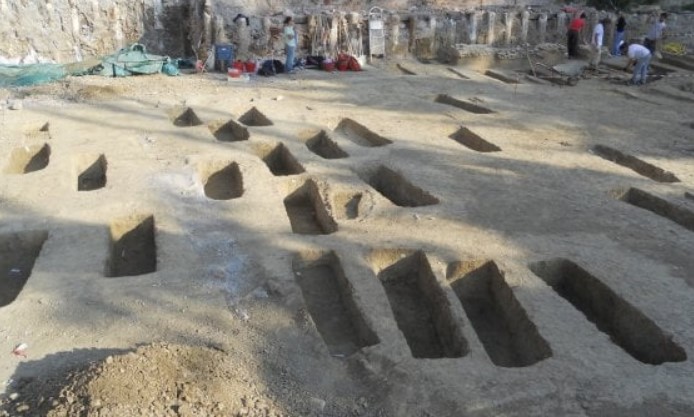 The Bologna medieval Jewish cemetery was recovered during archaeological excavations between 2012 and 2014. Destroyed in 1569, then long disappeared, it hosts 408 graves of men, women and children and is the largest one known in Italy so far and the second in Europe after York. In these graves, personal ornaments made of gold, silver, bronze, hard stones and amber were found.
The Bologna medieval Jewish cemetery was recovered during archaeological excavations between 2012 and 2014. Destroyed in 1569, then long disappeared, it hosts 408 graves of men, women and children and is the largest one known in Italy so far and the second in Europe after York. In these graves, personal ornaments made of gold, silver, bronze, hard stones and amber were found.
This cemetery is the witness to events that radically changed the history and life of a part of Bolognese citizens between the 14th and 16th century. At that time, for 176 years this place used to be the major burial ground of the Jewish community in Bologna, but after the papal bulls issued in the second half of the 16th century, authorizing the destruction of the Jewish cemeteries in the city, for centuries it survived only with the toponym "Jewish Garden".
According to existing archival sources, this area was purchased in the year 1393 by a member of the Jewish family named Da Orvieto, then given to the Bolognese Jewish community to be used as a burial site. This practice was interrupted in 1569, when two Papal Bulls condemned Jewish people to be expelled from every town within the Papal domains and to be cancelled from the memory of the places where they had lived until then. One of the most violent effects of these persecutions was the permission to destroy cemeteries and desecrate all the Jewish graves to be found in town. A true "condemnation of memory" that was only in part successful, since in the acts and registries of the following years, but most of all in the oral tradition, that area kept on being referred to as "Jewish Garden".
By the Papal Brief dated 28 November 1569, Pope Pius V donated the Jewish cemetery area to the nuns of the nearby church of Saint Peter Martyr, giving them the permission "to dig up and send, wherever they want, the bodies, bones and remains of the dead: to demolish, or convert to other forms, the graves built by the Jews, including those made for living people: to remove completely, or scrape off the inscriptions or epitaphs carved in the marble".
The archaeological excavation brought back to light the devastating effects of this papal act: about 150 graves, apparently tampered to offend the sacredness of the burials, and no trace of the tombstones that must have carried the names of the dead, as they had been probably sold or re-purposed. For example, the four beautiful Jewish gravestones now preserved and displayed at the Civic Medieval Museum of Bologna most probably came just from via Orfeo.
The cemetery area in Via Orfeo has now disclosed 408 burials perfectly aligned in parallel rows, with ditches dug in an east-west direction and heads of the dead on the west end.



Text adapted from an article published by Soprintendenza Archeologia, belle arti e paesaggio (Superintendence of Archeology, Fine Arts and Landscape) for the Metropolitan City of Bologna and the Provinces of Modena, Reggio Emilia e Ferrara (SABAP-BO)


